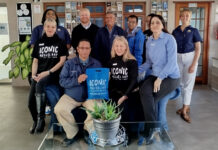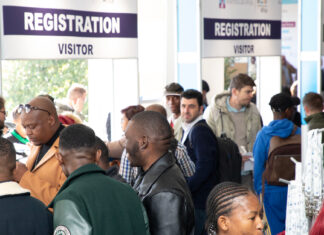In March 2019, a possible Polyphagous Shot Hole Borer beetle (PSHB) infestation was discovered in Oldenland Road, Somerset West, in an ailing London plane tree. In April 2019, DNA tests conducted by scientists confirmed it was a positive PSHB identification.
The City of Cape Town has developed best practice methods for the removal and disposal of trees infested with the invasive and insidious beetle. Horticulturists, landscapers, arborists or contractors assisting residents with the removal of dying or dead trees are requested to follow this protocol.
An experienced invasive species removal team from the City has since removed 46 trees from the Somerset West area in an attempt to contain and limit the spread of this invasive borer beetle. The wood from the trees that were cut down was chipped on site and carefully removed under cover of heavy duty plastic and incinerated at appropriate sites.
This week, the City of Cape Town’s Invasive Species Unit, in cooperation with the City’s Recreation and Parks Department, local arborists and the country’s top entomologists, released a PSHB Protocol which prescribes the best practice for how to remove and dispose of trees infested with PSHB.
The 18-page Polyphagous Shot Hole Borer Protocol is useful for identifying, pruning, cutting down, removing and disposing of PSHB-infected wood.
Other cases of these beetle infestations in California, Israel, and closer to home – Gauteng – have shown that the PSHB can easily spread across suburbs if extra precautions are not taken. Apart from infected wood, the borer beetle can also spread through clothing, vehicle crevices, or unclean horticultural equipment.
The authors of the protocol warn that the use of pesticides and fungicides have a limited effect. These may reduce the rate of recolonization in lightly infected trees, but have not proven effective at eradicating PSHB from infected trees.
The movement of infested wood is an important pathway for the spread of the beetle. Appropriate disposal of infested trees – by chipping and then incineration, solarisation, or composting – is therefore essential for reducing the spread of the pest.
Report PSHB beetle sightings online
The City encourages residents to report suspected sightings of a PSHB or fusarium dieback invasion online by visiting the Invasive Species Unit’s Shot Hole Borer Reporting Tool on www.capetowninvasives.org.za.
Click on “Report a PSHB sighting” to give your details and the location of the infected tree. Residents can also upload images of the tree and entrance tunnels as this will assist the City in a speedy identification.
Officials from the City’s Invasive Species Unit and an arborist at the City Parks and Recreation Department will conduct an investigation.
The website has an extensive database of information about PSHB where residents can learn more about this destructive beetle.
More about the PSHB beetle
– The beetle is the size of a sesame seed, approximately 2 mm in length, and its symbiont fungal partner have threatened trees across South Africa
– It is an ambrosia beetle native to Southeast Asia
– It was first discovered in South Africa in 2017 on London plane trees in KwaZulu-Natal’s National Botanical Gardens in Pietermaritzburg
– The beetle is invasive and poses a threat to exotic and indigenous trees across South Africa
– The beetle’s most likely pathway or vector is through the movement of infested wood, originating from dead or dying PSHB infested trees, including wood
– Intended to be used for cooking or heating.
The following trees are invaded by these beetles
– Alien trees infested to date include London plane trees, Liquid amber, Japanese maples, Chinese maples, pin oaks, and English oaks
– Indigenous trees invaded to date include the Coast Coral tree, Forest Bushwillow, and the Cape willow.
What to do
– Burning the infected wood is the preferred method
– Chipping the wood into small pieces for compost is also recommended as the heat buildup in the composting process will kill the beetle
– Once the tree has been felled the debris should be cleared as soon as possible and if required, the area should be sanitised
– Infested plant material can be placed in refuse bags and sealed. The bags must be put in direct sunlight for solarisation as the heat from the sun helps to kill the beetle and its larvae.















